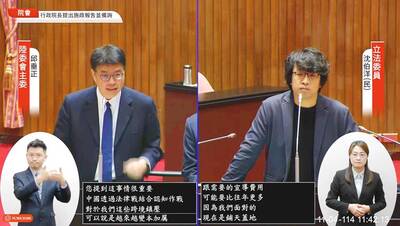The nation's long-awaited high speed railway began operation yesterday, marking a milestone in the nation's transportation history amid safety concerns and spotty ticketing service.
The new rail system service started with two trains departing from the line's northern stop in Banciao (板橋), Taipei County, and its southern stop in Tsoying (左營), Kaohsiung City, at 7am sharp.
Both trains traveled at a maximum speed of 300kph and arrived at their destinations at 8:30am, cutting normal train travel time by two-and-a-half-hours.
The section between Taipei and Banciao stations is still under construction. The high-speed rail service has been delayed since the end of October last year owing to problems with its core electrical system.
Undaunted by problems with the ticketing service because of a system malfunction, most passengers were excited to board the trains and satisfied with the ride.
"Despite some small problems, the situation remained under control [and we should be able] to solve [the problems] soon," Arthur Chiang (江金山), spokesman for Taiwan High Speed Rail Corp (THSRC, 台灣高鐵), the operator of the bullet train, said yesterday.
THSRC is in charge of operating the build-operate-transfer (BOT) railway project for 35 years before it is turned over to the government's control.
The company has been making surveys of passengers after each ride and has not yet received any major complaints, Chiang said.
Some passengers complained that they found their seats were already taken and were forced to take the next train.
THSRC announced on Thursday that it had found a glitch in the booking system that led to double bookings on 831 seats.
To solve the overbooking problem, THSRC provided an additional eight trains to carry those passengers, as well as offering each passenger a free ticket.
The company's solution has drawn criticism, however, as the Ministry of Transportation and Communications approved the operation of only 19 trains running in each direction per day.
Chiang defended the company's actions, saying the trains were needed to serve the needs of the 831 passengers and that the provisional dispatch was approved by the Bureau of High Speed Rail.
As THRSC had conducted intensive test-runs before the service's launch, the operation of the additional trains should not be a cause for concern, he said.
The company estimated that more than 30,000 people would be departing or arriving at the Banciao Station on the first day of its service.
The launch of the new railway system came amid numerous complaints over the past few days about ticket sales. To pacify consumers, THSRC said on Thursday that it would extend the half-priced fares until Jan. 19.
In Taichung, however, the service's launch was marred by conflict between representatives of a consumer advocacy group and an unidentified group of 20 people.
The group of 20 surrounded volunteers representing the Consumers' Foundation in the morning, snatching and destroying the posters and threatening them.
The foundation yesterday had dispatched volunteers and employees to the high-speed rail system's stations in Banciao, Taichung and Tsoying to advise passengers not to take the new transportation means before safety concerns were eased.
The conflict in Taichung nearly led to physical clashes, with a man in the Taichung station shouting at the foundation's representative: "Chinese dogs. Go back to China."
Foundation chairman Cheng Jen-hung (程仁宏) expressed regret over the protest, saying that it was a pity to see their "soft persuasion" efforts tainted by political color.
Cheng said that in consideration of its volunteers, the foundation would halt its on-site persuasion and launch a second-stage activity by collecting consumers' endorsement on the Internet.
"After gathering the public's opinions, we'll visit the Minister of Transportation and Communications soon to express our opinion and demand that the government clarify safety guarantee regulations for passengers," he said.
Still, the presence of a French driver, Patrick Poulenas, controlling the Japanese-designed bullet train yesterday reflected the checkered history of the project, first conceived in the 1990s and based on the Eurotrain of Alstom-Siemens. But in 1998 THSRC -- reportedly on the order of then-president Lee Teng-hui (
Poulenas and his 39 compatriots, along with 13 German drivers operate the trains, but THSRC hopes local drivers will replace them within 18 months.
Additional reporting by AFP
also see story:
Editorial: Here's to a safe rail system

CALL FOR SUPPORT: President William Lai called on lawmakers across party lines to ensure the livelihood of Taiwanese and that national security is protected President William Lai (賴清德) yesterday called for bipartisan support for Taiwan’s investment in self-defense capabilities at the christening and launch of two coast guard vessels at CSBC Corp, Taiwan’s (台灣國際造船) shipyard in Kaohsiung. The Taipei (台北) is the fourth and final ship of the Chiayi-class offshore patrol vessels, and the Siraya (西拉雅) is the Coast Guard Administration’s (CGA) first-ever ocean patrol vessel, the government said. The Taipei is the fourth and final ship of the Chiayi-class offshore patrol vessels with a displacement of about 4,000 tonnes, Lai said. This ship class was ordered as a result of former president Tsai Ing-wen’s (蔡英文) 2018

‘SECRETS’: While saying China would not attack during his presidency, Donald Trump declined to say how Washington would respond if Beijing were to take military action US President Donald Trump said that China would not take military action against Taiwan while he is president, as the Chinese leaders “know the consequences.” Trump made the statement during an interview on CBS’ 60 Minutes program that aired on Sunday, a few days after his meeting with Chinese President Xi Jinping (習近平) in South Korea. “He [Xi] has openly said, and his people have openly said at meetings, ‘we would never do anything while President Trump is president,’ because they know the consequences,” Trump said in the interview. However, he repeatedly declined to say exactly how Washington would respond in

WARFARE: All sectors of society should recognize, unite, and collectively resist and condemn Beijing’s cross-border suppression, MAC Minister Chiu Chui-cheng said The number of Taiwanese detained because of legal affairs by Chinese authorities has tripled this year, as Beijing intensified its intimidation and division of Taiwanese by combining lawfare and cognitive warfare, the Mainland Affairs Council (MAC) said yesterday. MAC Minister Chiu Chui-cheng (邱垂正) made the statement in response to questions by Democratic Progressive Party (DPP) Legislator Puma Shen (沈柏洋) about the government’s response to counter Chinese public opinion warfare, lawfare and psychological warfare. Shen said he is also being investigated by China for promoting “Taiwanese independence.” He was referring to a report published on Tuesday last week by China’s state-run Xinhua news agency,

‘ADDITIONAL CONDITION’: Taiwan will work with like-minded countries to protect its right to participate in next year’s meeting, the foreign ministry said The US will “continue to press China for security arrangements and protocols that safeguard all participants when attending APEC meetings in China,” a US Department of State spokesperson said yesterday, after Beijing suggested that members must adhere to its “one China principle” to participate. “The United States insists on the full and equal participation of all APEC member economies — including Taiwan — consistent with APEC’s guidelines, rules and established practice, as affirmed by China in its offer to host in 2026,” the unnamed spokesperson said in response to media queries about China putting a “one China” principle condition on Taiwan’s